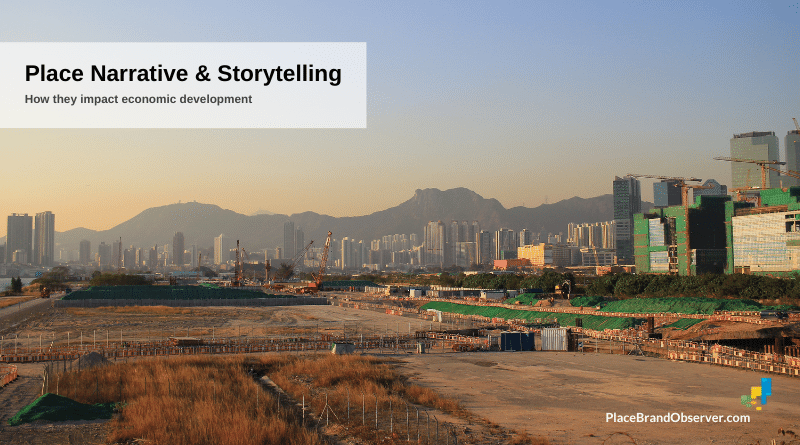Cities, regions and countries can thrive only when they are open to a sustainable long-term development trajectory by inviting the best minds and businesses to work together. This is achieved by communicating the opportunities for growth that are available for skilled workers, and businesses. The narrative that is built to attract these drivers of growth determines the future of these places.
We asked our panel of place makers and shapers (in alphabetical order – highlighted respondents are available for consulting or as speakers) how storytelling and place narratives can shape the socio-economic aspects of a location- city, region or country.
Our key takeaways:
- The place narrative should accompany actual development – both social and economic.
- Place branding gives an opportunity for cities to reimagine and reposition themselves: overcoming an unfavourable image or difficult past. It is a chance to drive growth in your own, favourable terms.
- With effective storytelling, place branding can build a sense of belonging among new residents and locals alike.
- Honesty is the best (communications) strategy. Being honest and realistic about the opportunities available or offered at your location helps to attract the right talent and to drive economic development.
- Place narrative is built on what a region, country or city aspires to be. This, in turn, prompts stakeholders to work towards becoming what is being projected and ensures development efforts are aligned with the overall direction (the big picture or vision).
- Place branding focuses on certain verticals like talent attraction, tourism or economic development. Those often still operate in silos. Storytelling and place narrative can help to connect the dots and to bring different players together around a shared vision and theme.
Andrew Hoyne
Australia | A strong narrative and place branding has never been more critical to a city’s success. With over 3,000 cities globally targeting talent and investment, it is an extremely competitive market out there. So I’m truly shocked when I hear intelligent, business-minded people fail to understand the power and importance of a great place brand. Do they want their city to flounder amid myriad better branded, engaging cities and bid farewell to the significant social and economic benefits a strong place brand could bring?
Place branding helps to shape a community and increase economic opportunities for citizens, and for businesses of all sizes. It can create competitive commercial advantages, communicating why people should visit, open a business in a place or invest money there. This helps to future-proof your city, ensuring success now and for decades to come.
It should be seen as an optimistic, positive endeavour that creates value. It amplifies positive differences and celebrates what makes a place unique. It’s a call to action and today it is a non-negotiable factor for any city wishing to prosper. The right outcome will also deliver an improved reputation and increased civic pride.
Caio Esteves
Brazil | First of all, it must be said that a narrative by itself, no matter how good it is, is not capable of transforming absolutely anything, or at least not in a permanent and sustainable way. One of the dimensions of the “Antifragile City”, my most recent book, is action-based narrative. It is necessary to do more than talk, nothing more obvious and at the same time often ignored by many.
Place branding, which should be the origin of the action-based narrative, has an obligation for the economic and social impact of places. For me, there is no economic impact without a positive social impact.
If place brands identify vocations and enhance the identities of the place, then the social-economic impact is in the very essence of place branding. Boosting the “best” of the place is to promote it externally, but mainly, to engage it internally. This is only possible thanks to popular participation in collaborative and co-creative processes, which often involve the training of local know-how that was outdated due to the speed of the market or a disorganized productive/receptive process.
In short, if place branding does not have a positive impact both economically and socially, something was done wrong.
Ed Burghard
USA | Place Branding = Place Making + Place Marketing
A better word than “narrative” is a promise. An effective place promise focuses on how the community will uniquely enable a better life for residents. Place branding is all about ensuring the promise is authentic, relevant and competitive at each touchpoint for residents.
This requires communities to make strategic choices that support the realization of their promise in the areas of capital investment/attraction, infrastructure creation/maintenance, and public policy/programming. The latter is about making certain that even the most vulnerable in a community have an opportunity to realize the place promise. Like any brand, the promise should drive strategic choices for a community. It should focus on ensuring a culture that will enrich the lives of residents, including protecting the most vulnerable among us.
Günter Soydanbay
Soydanbay Consulting / Speaker
Canada | A good example is Minsk, the capital and largest city of Belarus. I would assume that most people would draw a blank when asked about Minsk.
The brand is built around the fact that many Minsk residents are third-generation manufacturers, designers, and builders. So, Minsk tells the narrative of the engineer archetype.
“Need people who can think?” is a great campaign that makes residents feel proud of Minsk and develop a unique city culture based on their distinct character while also helping improve Minsk’s international profile to attract foreign investment, tourist visitors, and creative talent.
Jeannette Hanna
Trajectory Brand Consultants / Speaker profile
Canada | Charles Landry – the “creative cities” pioneer – argues that, “the stories we tell ourselves are a big part of how we become us.”
There are numerous success stories of places that have reimagined themselves with powerful social and economic impact. Eindhoven in the Netherlands suffered a dramatic setback in the 1990s when Phillips announced major layoffs – nearly one-third of the population lost their jobs.
The city repositioned its engineering prowess – expertise that Philips had helped to attract and grow – with a strategy focused on demonstrating its unconventional approach to innovation. Within a few years, and some high-visibility urban design triumphs, Wired Magazine and others were touting Eindhoven as a “vibrant research and technology hub.”
Detroit also pulled itself out of an economic death spiral by rewiring its automotive monoculture into a narrative of resilient design, engineering and “maker” creativity.
Successful place brands leverage a sense of genius loci – the authentic spirit and heritage of a locale – but reinterpret those strengths and values to suit future ambitions. According to social scientists, changing mental models is vital to any systems change. That’s the key value of place brands.
Martin Boisen
For the love of place / Researcher profile
The Netherlands | In a multitude of ways. First and foremost, it can increase the feeling of belonging and the feeling of attachment to the place. From there, it can also increase the feeling of community amongst the people living their daily lives in and around that place.
Of course, this also means that it can do the exact opposite of all of that – something we’ve seen in places where pure commercial interests have led growth coalitions to take control of the brand of the place to commodify it, without respecting the deep cultural elements it also represents.
Sebastian Zenker
Denmark | Place branding can give meaning to a place, as well as create a joint identification for the place inhabitants. This gives a social impact as identification with a place is an important driver of place satisfaction. Economically, it creates the decision to stay at a place (talents, companies) or to select a certain place (residents, companies and tourists).
Todd Babiak
Australia | Narrative is the glue, a way to sing the song of a place and its culture. Single concept and traditional tagline-and-logo branding can’t capture what makes a place utterly unique the way a unifying story can.
A culturally specific yet flexible story can unify efforts across trade and tourism, student and investment attraction, and invite both citizens and potential new arrivals to make powerful choices about why they live where they live and what to do about it. We have to help our partners use it without being ‘brand police’.
Andrea Lucarelli
Sweden | If you want to show how narrative, for example, storytelling can convey that place branding could be suitable for the development of places, then I think this is very important. A way to present place branding as feasible and attractive for different stakeholders is crucial. The way to convince different stakeholders and talk them across what can be the impact to locals is important. Also, do not forget that is not social and economic, but the political impact is important to recall.
Aparna Sharma
India | The narrative and place branding need to be cogently bound and promoted together. The touchpoints should be identified as the levers for socio-economic development and made part of the master narrative. These should be prioritised and highlighted both as part of the master narrative and place branding.
The buy-in from the government institutions and the people at large is an essential prerequisite to building and driving the narrative for achieving the desired results. An amenable policy framework is extremely important for the change agents and those driving the narrative/place branding to sustain the socio-economic development agenda.
Cecilia Cassinger
Sweden | Narratives give meaning to places and maybe mobilized in place branding to attract flows of capital as well as to strengthen social communities. The potential of mobilizing narratives in place branding is that they may change an unfavourable image of a place and positively affect how people act in relation to it.
I find it useful to think of place branding as a form of aspirational communication. Such communication practices do not passively represent a place but do something to and with places. Sometimes we say that place branding strategy needs to be anchored in the reality of city residents, in their everyday practices. By contrast, aspirational talk is anchored in a future image of the city, in other words, it does not represent the city as it is, but as it could be. Aspirational talk may activate residents to start conversations that shape new and bolder narratives that can reinvigorate places.
Cecilia Pasquinelli
Italy | This is one of the big questions in the place branding field. We can identify the socio-economic impacts of place branding whenever we are able to trace and provide evidence of the link between place brand narratives and behaviours (policymakers’, entrepreneurs’, citizens’, tourists’, workers’, students’ behaviours).
I think this is one of the most compelling perspectives on place branding and a more systematic effort should be done particularly to frame the impact of the place brand on the local “innovation capacity”, on its effectiveness in encouraging local stakeholders to reinterpret and re-envision consolidated paths of local development, on steering dialogue within the local community and providing it with a platform (physical and digital platform) for continuous dialogue in concrete.
Gustavo Koniszczer
Argentina | I like the phrase “there isn’t a second chance to cause a memorable first impression”. This simply means that when you have to convince investors, business people or tourists to invest in, buy products from or visit your place, the risk to miss the opportunity is very high if you don’t have a clear narrative already developed and strategically ready to enter in action. Place branding is the most effective and known way to coordinate communication objectives through unified storytelling that must be built around all interested stakeholders.
Irina Shafranskaya
Russia | In Russia we have several examples of social entrepreneurship projects which, first, became brands and then place brands. The typical framework here is “location, communication, vacation/vocation”.
First, the place becomes known due to the impactful entrepreneurial activity. For example, a young entrepreneur launches a ‘glocal business’ that attracts lots of attention. It drives engagement and increases the awareness of the place, people start to choose it as a weekend activity, retreat destination, whatever. And at the same time, the place brand is developing organically, illustrating that this is a certain vocation of the founder. You can read more about the story here.
Jaume Marín
Spain | Place branding has become very important, not only for tourism but for economic development overall. As principles of communication, a destination needs to create awareness and then stir desire In different target markets they would like to focus on. Branding provides a sense of “trust” to the potential client, and they have a perceived image that is going to be very relevant at the time they have to dream/plan/travel/invest in a specific place or location.
It is now, very important, that this narrative is shared by all the different stakeholders of the destination, and even more important now, it is in all the different stages of the trip, from planning to the present trip to the destination, and afterwards, when they share it on social media channels.
Jordi de San Eugenio Vela
Spain | In my opinion, that is an issue directly related to positioning. If you explain the advantages of your place from an honest point of view and use the right channels to project and disseminate your competitive identity, the place branding strategy creates an interesting environment for the economic development of places.
José Pablo Arango
Colombia | To the extent that the narrative represents and promotes the vocation of the territory and presents its offer in a relevant and attractive way, it will undoubtedly help to boost its economic and social development.
Marcus Andersson
Sweden | The most obvious is that a successful place branding effort will attract companies or people that will help advance the economic or social development of your place, but a well-functioning place branding effort and its brand promise can also help focus or trigger development efforts.
If you claim that you are the most innovative city or region in your country, you need to deliver on that promise in different policy and economic development efforts. The same goes for social development. Let’s say your place claims to be a diverse and tolerant place, then you need to make sure you live up to that promise in policy and development efforts – and find ways to communicate achievements that support the branding effort.
Stella Kladou
Turkey | Place branding may be increasingly more popular as a term, yet its practices are quite often top-down directed. As a result, place branding strategies prioritize the decision makers’ understanding and vision of the place and may ignore narratives reflecting the actual place identity.
Place branding strategies are rarely completely inclusive: narratives chosen to project the sense of place tend to reflect the desirable sense of place – which may be relevant to specific resident groups and brand assets. Strategies often also highlight one aspect of place branding (e.g. tourism), thereby providing initiatives that boost specific types of development: For instance, when tourism development is the ultimate place branding objective, locals will abandon traditional professions for a job in tourism, and tourism infrastructure will add pressures on primary sector activities.
Inclusive place branding and narratives can have a positive impact on the social and economic development of places, but such efforts take more time, effort and maturity than actors usually exhibit. The harvest festival of Öland in Sweden is a positive example of how the sense of place can boost rural social sustainability in embracing those residents’ sense of place who have just moved to the island.
Similarly, the Lismore festival in Australia seeks to create new narratives for the place by bringing together all residents, the immigrants’ customs and practices brought from their homelands with their ancestors. As the quote goes, wherever there is a will, there is a way; hopefully, the more place branding actors mature, the more common resilient practices will be.
Previous questions answered by the panel here.
You’d like to ask the panel a question? Get in touch!
Enjoyed this snapshot of expert views on how place narrative and storytelling can impact the economic development of locations – as attractive places to visit, live or invest in? Thanks for spreading the word!










